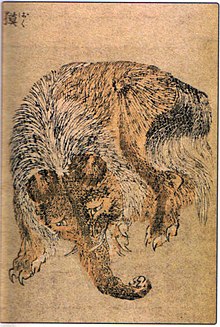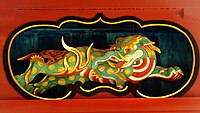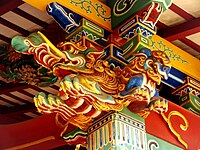| Revision as of 19:14, 1 July 2015 editKSFT (talk | contribs)Extended confirmed users, Pending changes reviewers, Rollbackers6,192 editsm Reverted edits by Rolandi+ (talk): Failure to cite a reliable source (HG) (3.1.13)← Previous edit | Latest revision as of 02:39, 17 September 2024 edit undoRsjaffe (talk | contribs)Administrators55,996 editsm clean up, typo(s) fixed: chinese → Chinese, ’s → 's (3)Tag: AWB | ||
| (95 intermediate revisions by 65 users not shown) | |||
| Line 1: | Line 1: | ||
| {{short description|Chinese supernatural beings}} | |||
| {{other uses|Baku (disambiguation)}} | |||
| {{DISPLAYTITLE:''Baku'' (mythology)}} | |||
| ].]] | ].]] | ||
| {{nihongo|'''''Baku'''''|{{linktext|獏}} {{lang|en|or}} {{linktext|貘}}}} are Japanese ] that are said to devour nightmares. They originate from the Chinese ]. According to legend, they were created by the spare pieces that were left over when the gods finished creating all other animals. They have a long history in ] and ], and more recently have appeared in ] and ]. | |||
| ⚫ | The Japanese term ''baku'' has two current meanings, referring to both the traditional dream-devouring creature and to the ].<ref name="nakagawa">{{cite journal|author=Nakagawa Masako|year=1999|title=Sankai ibutsu: An early seventeenth-century Japanese illustrated manuscript|journal=Sino-Japanese Studies|volume=11|issue=24–38|pages=33–34}}</ref> In recent years, there have been changes in how the ''baku'' is depicted. | ||
| {{nihongo|'''Baku'''|獏{{lang|en| or }}貘}} are Japanese supernatural beings that devour dreams and nightmares. They have a long history in Japanese folklore and art, and more recently have appeared in Japanese ] and ] (see examples cited below). | |||
| ⚫ | The Japanese term ''baku'' has two current meanings, referring to both the traditional dream-devouring creature and to |
||
| ==History and description== | ==History and description== | ||
| The traditional Japanese nightmare-devouring baku originates in ] and was familiar in Japan as early as the ] |
The traditional Japanese nightmare-devouring ''baku'' originates in ] from the '']'' 貘 (]) and was familiar in Japan as early as the ] (14th–15th century).<ref>Hori Tadao 2005 "Cultural note on dreaming and dream study in the future: Release from nightmare and development of dream control technique," ''Sogical Rhythms'' 3 (2), 49–55.</ref> Hori Tadao has described the dream-eating abilities attributed to the traditional ''baku'' and relates them to other preventatives against nightmare such as ]s. ], citing a 1957 paper, and Mizuki also describe the dream-devouring capacities of the traditional ''baku''.<ref>Mizuki, Shigeru 2004 ''Mujara 5: Tōhoku, Kyūshū-hen'' (in Japanese). Japan: Soft Garage. page 137. {{ISBN|4-86133-027-0}}.</ref> | ||
| Before its adaptation to the Japanese dream-caretaker myth creature, an early 17th-century Japanese manuscript, the ''Sankai Ibutsu'' ({{nihongo2|山海異物}}), describes the ''baku'' as a shy, Chinese mythical ] with the trunk and tusks of an ], the ears of a ], the tail of a ], the body of a ] and the paws of a ], which protected against pestilence and evil, although eating nightmares was not included among its abilities.<ref name="nakagawa"/> However, in a 1791 Japanese wood-block illustration, a specifically dream-destroying ''baku'' is depicted with an elephant's head, tusks, and trunk, with horns and tiger's claws.<ref>Kern, Adam L. 2007 ''Manga from the Floating World: Comicbook culture and the kibyoshi of Edo Japan''. Cambridge: Harvard University Asian Center. Page 236, figure 4.26.</ref> The elephant's head, trunk, and tusks are characteristic of ''baku'' portrayed in classical era (pre-]) Japanese wood-block prints (see illustration) and in shrine, temple, and ] carvings.<ref>{{nihongo2|}}. (Accessed September 5, 2007.)</ref><ref>Richard Smart, "", ''Japan Times,'' February 16, 2007. (Accessed September 8, 2007.)</ref><ref>{{cite web|title=Shinto Shrine Guide - Iconography, Objects, Superstitions in Japanese Shintoism|website=Onmark Productions|url=http://www.onmarkproductions.com/html/shrine-guide-2.shtml|access-date=September 8, 2007|url-status=live|archive-url=https://web.archive.org/web/20071016052721/http://www.onmarkproductions.com/html/shrine-guide-2.shtml|archive-date=October 16, 2007}}</ref><ref>{{cite web|title=Baku: Monster that Eats Nightmares|website=] Collections|url=https://collections.lacma.org/node/192199|url-status=live|archive-date=October 29, 2017 |archive-url=https://web.archive.org/web/20171029091750/https://collections.lacma.org/node/192199|access-date=October 12, 2010}}</ref> | |||
| Writing in the ], ] (1902) described a ''baku'' with very similar attributes that was also able to devour nightmares.<ref>Hearn, Lafcadio 1902 Kottō: ''Being Japanese Curios, with Sundry Cobwebs''. Macmillan. Pages 245–248. {{ISBN|4-86133-027-0}}.</ref> | |||
| Legend has it that a person who wakes up from a bad dream can call out to ''baku''. A child having a nightmare in Japan will wake up and repeat three times, "Baku-san, come eat my dream." Legends say that the ''baku'' will come into the child's room and devour the bad dream, allowing the child to go back to sleep peacefully. However, calling to the ''baku'' must be done sparingly, because if he remains hungry after eating one's nightmare, he may also devour their hopes and desires as well, leaving them to live an empty life. The ''baku'' can also be summoned for protection from bad dreams prior to falling asleep at night. In the 1910s, it was common for Japanese children to keep a ''baku'' talisman at their bedside.<ref>M.Reese:"The Asian traditions and myths".pg.60</ref><ref>Hadland Davis F., "Myths and Legends of Japan" (London: ], 1913)</ref> | |||
| ==Gallery== | ==Gallery== | ||
| <gallery> | <gallery heights="200" widths="200"> | ||
| KonnoHachiman-Sculpture-1.jpg|Baku at the Konnoh Hachimangu Shrine, ], ], ] | KonnoHachiman-Sculpture-1.jpg|''Baku'' sculpture at the Konnoh Hachimangu Shrine, ], ], ] | ||
| KonnoHachiman-Sculpture-3.jpg|Baku and Lion at the Konnoh Hachimangu Shrine, Shibuya, Tokyo, Japan | KonnoHachiman-Sculpture-3.jpg|''Baku and Lion'' sculpture at the Konnoh Hachimangu Shrine, Shibuya, Tokyo, Japan | ||
| </gallery> | </gallery> | ||
| ==See also== | ==See also== | ||
| * ] | * ] | ||
| == |
==References== | ||
| <references group="n" /> | |||
| == References == | |||
| {{Reflist}} | {{Reflist}} | ||
| ==Bibliography== | |||
| * ]. International Research Center for Japanese Studies. Retrieved on 2007-05-12. (Summary of excerpt from ''Warui Yume o Mita Toki'' ({{nihongo2|悪い夢をみたとき}}, When You've Had a Bad Dream?) by Keidō Matsushita, published in volume 5 of the journal ''Shōnai Minzoku'' ({{nihongo2|庄内民俗}}, Shōnai Folk Customs) on June 15, 1957). | * ]. International Research Center for Japanese Studies. Retrieved on 2007-05-12. (Summary of excerpt from ''Warui Yume o Mita Toki'' ({{nihongo2|悪い夢をみたとき}}, When You've Had a Bad Dream?) by Keidō Matsushita, published in volume 5 of the journal ''Shōnai Minzoku'' ({{nihongo2|庄内民俗}}, Shōnai Folk Customs) on June 15, 1957). | ||
| == |
==External links== | ||
| {{Commons category|Baku (mythology)}} | |||
| * at hyakumonogatari.com (English). | * at hyakumonogatari.com (English). | ||
| *, an exhibition catalog from The Metropolitan Museum of Art (fully available online as PDF), which contains many representations of Baku | * , an exhibition catalog from The Metropolitan Museum of Art (fully available online as PDF), which contains many representations of Baku | ||
| {{Japanese folklore long}} | |||
| {{DEFAULTSORT:Baku}} | {{DEFAULTSORT:Baku}} | ||
Latest revision as of 02:39, 17 September 2024
Chinese supernatural beings
Baku (獏 or 貘) are Japanese supernatural beings that are said to devour nightmares. They originate from the Chinese Mo. According to legend, they were created by the spare pieces that were left over when the gods finished creating all other animals. They have a long history in Japanese folklore and art, and more recently have appeared in manga and anime.
The Japanese term baku has two current meanings, referring to both the traditional dream-devouring creature and to the Malayan tapir. In recent years, there have been changes in how the baku is depicted.
History and description
The traditional Japanese nightmare-devouring baku originates in Chinese folklore from the mo 貘 (giant panda) and was familiar in Japan as early as the Muromachi period (14th–15th century). Hori Tadao has described the dream-eating abilities attributed to the traditional baku and relates them to other preventatives against nightmare such as amulets. Kaii-Yōkai Denshō Database, citing a 1957 paper, and Mizuki also describe the dream-devouring capacities of the traditional baku.
Before its adaptation to the Japanese dream-caretaker myth creature, an early 17th-century Japanese manuscript, the Sankai Ibutsu (山海異物), describes the baku as a shy, Chinese mythical chimera with the trunk and tusks of an elephant, the ears of a rhinoceros, the tail of a cow, the body of a bear and the paws of a tiger, which protected against pestilence and evil, although eating nightmares was not included among its abilities. However, in a 1791 Japanese wood-block illustration, a specifically dream-destroying baku is depicted with an elephant's head, tusks, and trunk, with horns and tiger's claws. The elephant's head, trunk, and tusks are characteristic of baku portrayed in classical era (pre-Meiji) Japanese wood-block prints (see illustration) and in shrine, temple, and netsuke carvings.
Writing in the Meiji period, Lafcadio Hearn (1902) described a baku with very similar attributes that was also able to devour nightmares. Legend has it that a person who wakes up from a bad dream can call out to baku. A child having a nightmare in Japan will wake up and repeat three times, "Baku-san, come eat my dream." Legends say that the baku will come into the child's room and devour the bad dream, allowing the child to go back to sleep peacefully. However, calling to the baku must be done sparingly, because if he remains hungry after eating one's nightmare, he may also devour their hopes and desires as well, leaving them to live an empty life. The baku can also be summoned for protection from bad dreams prior to falling asleep at night. In the 1910s, it was common for Japanese children to keep a baku talisman at their bedside.
Gallery
-
 Baku sculpture at the Konnoh Hachimangu Shrine, Shibuya, Tokyo, Japan
Baku sculpture at the Konnoh Hachimangu Shrine, Shibuya, Tokyo, Japan
-
 Baku and Lion sculpture at the Konnoh Hachimangu Shrine, Shibuya, Tokyo, Japan
Baku and Lion sculpture at the Konnoh Hachimangu Shrine, Shibuya, Tokyo, Japan
See also
References
- ^ Nakagawa Masako (1999). "Sankai ibutsu: An early seventeenth-century Japanese illustrated manuscript". Sino-Japanese Studies. 11 (24–38): 33–34.
- Hori Tadao 2005 "Cultural note on dreaming and dream study in the future: Release from nightmare and development of dream control technique," Sogical Rhythms 3 (2), 49–55.
- Mizuki, Shigeru 2004 Mujara 5: Tōhoku, Kyūshū-hen (in Japanese). Japan: Soft Garage. page 137. ISBN 4-86133-027-0.
- Kern, Adam L. 2007 Manga from the Floating World: Comicbook culture and the kibyoshi of Edo Japan. Cambridge: Harvard University Asian Center. Page 236, figure 4.26.
- 夢貘まくら. (Accessed September 5, 2007.)
- Richard Smart, "Delivering men from evil", Japan Times, February 16, 2007. (Accessed September 8, 2007.)
- "Shinto Shrine Guide - Iconography, Objects, Superstitions in Japanese Shintoism". Onmark Productions. Archived from the original on October 16, 2007. Retrieved September 8, 2007.
- "Baku: Monster that Eats Nightmares". LACMA Collections. Archived from the original on October 29, 2017. Retrieved October 12, 2010.
- Hearn, Lafcadio 1902 Kottō: Being Japanese Curios, with Sundry Cobwebs. Macmillan. Pages 245–248. ISBN 4-86133-027-0.
- M.Reese:"The Asian traditions and myths".pg.60
- Hadland Davis F., "Myths and Legends of Japan" (London: G. G. Harrap, 1913)
Bibliography
- Kaii-Yōkai Denshō Database. International Research Center for Japanese Studies. Retrieved on 2007-05-12. (Summary of excerpt from Warui Yume o Mita Toki (悪い夢をみたとき, When You've Had a Bad Dream?) by Keidō Matsushita, published in volume 5 of the journal Shōnai Minzoku (庄内民俗, Shōnai Folk Customs) on June 15, 1957).
External links
- Baku – The Dream Eater at hyakumonogatari.com (English).
- Netsuke: masterpieces from the Metropolitan Museum of Art, an exhibition catalog from The Metropolitan Museum of Art (fully available online as PDF), which contains many representations of Baku